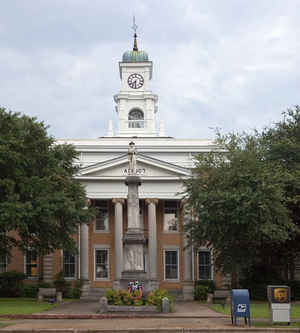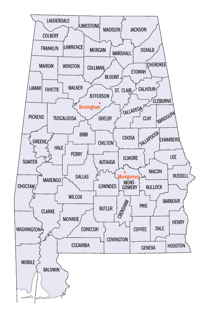Hale County, Alabama History
Hale County Education, Geography, and History
Hale County is a county of the state of Alabama. Based on the 2010 census, the
population was 15,760. Hale County was created
on January 30, 1867 and formed from Greene County, Marengo County, Perry
County, and Tuscaloosa County. The county seat is Greensboro.
Hale county is named in honor of Confederate officer Stephen Fowler Hale.
Hale County is part of the Tuscaloosa, AL Metropolitan Statistical Area.
Etymology - Origin of Hale County Name
Hale county was named for Lieutenant Colonel Stephen Fowler Hale, a Confederate officer killed at Gaines' Mill, Virginia.
Demographics:
County QuickFacts: CensusBureau Quick Facts
Hale County History
Hale County, Alabama
Hale county was formed by the Alabama legislature on January 30, 1867. The county was named for Lieutenant Colonel Stephen Fowler Hale, a Confederate officer killed at Gaines' Mill, Virginia. Hale County is located in the west-central section of the state, and is drained by the Black Warrior River. Hale County is bordered by Tuscaloosa, Bibb, Perry, Marengo, and Greene counties. It encompasses 661 square miles. Greensboro is the county seat. Other towns and communities include Moundville, Havana, Wedgeworth, Cedarville, and Sledge.
Hale County is connected to three major twentieth century artists: Walker Evans photographed the area in 1936 while he collaborated with
James Agee on the 1941 book Let Us Now Praise Famous Men. Since the 1960s, artist William Christenberry, born in Tuscaloosa, has been
photographing various structures in Hale County as part of his multi-media artistic investigations. More recently, Hale County has become the
home of the nationally-recognized Auburn University Rural Studio, an architectural outreach program founded by architect and artist Samuel
Mockbee and D. K. Ruth. It is also the birthplace of Eugene Sawyer, the second African American mayor of Chicago.
Since the American Civil War, whites controlled economic and political power in Hale County. However, in 1997 after a highly contested mayoral
election the city of Greensboro elected its first black mayor, John E. Owens Jr. In 2006, both black and white county residents came together
and elected their first black sheriff, Kenneth W. Ellis, who was formerly the Moundville police chief.
Like many Blackbelt counties, Hale County has experienced economic decline, particularly in the southern end of the county. Many businesses
and manufacturing plants have closed in and around Greensboro (the county seat). The northern portion of the county, however, has experienced
population and industrial growth due to its close proximity to Tuscaloosa County
Geography: Land and Water
As reported by the Census Bureau, the county has a total area of 657 square miles (1,700 km2), of which 644 square miles (1,670 km2) is land and 13 square miles (34 km2) (1.9%) is water.
The Black Warrior River and its lower tributaries flow throughout Hale County. The Black Warrior River System is the largest watershed wholly within Alabama's state boundaries and is unique in that it emanates from three sources: Locust Fork, Mulberry Fork, and the Sipsey Fork. The Black Warrior River is considered amongst the most critical watersheds in the nation and is home to several species of at-risk fish and mussels.
Neighboring Counties
Bordering counties are as follows:
- North: Tuscaloosa County
- Northeast: Bibb County
- Southeast: Perry County
- Southwest: Marengo County
- Northwest: Greene County
Tourism
Greensboro, the county seat, is home to the 'Safe House Museum'. On March 21, 1968, Martin Luther King Jr. attended a meeting at
Greensboro's St. Matthew Church, and then spent the night in this house where he sought refuge from the Ku Klux Klan. The museum reveals the
struggle for equality for African Americans in Alabama, and its curator, Ms. Theresa Burroughs, was both a family friend of King, and a foot
soldier in the Civil Rights Movement.
Greensboro is also home to a large number of antebellum-era houses and churches, including some that are listed on the National Register of
Historic Places such as Glencairn and Magnolia Grove.
Education







